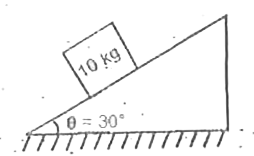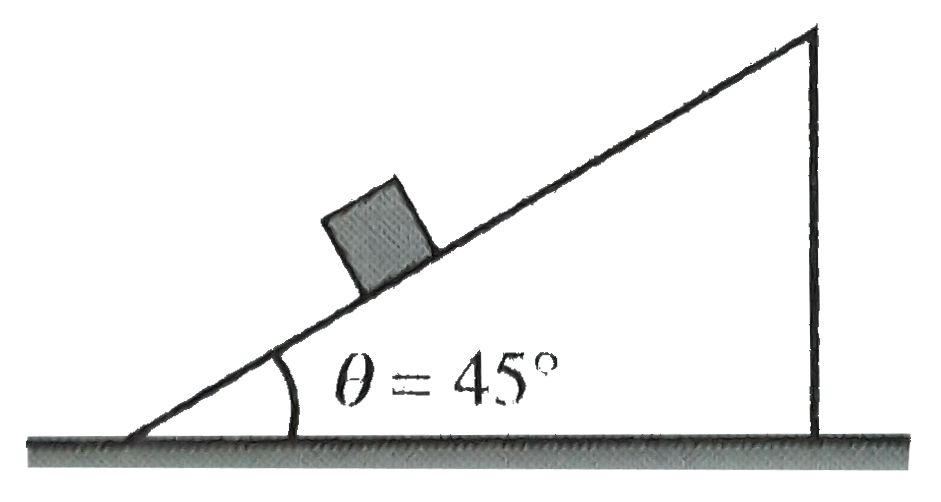A small block of mass 1kg is kept on a rough inclined wedge of inclination 45∘ fixed in an elevator. The elevator goes up with a uniform velocity v=2m/s and the block does not slide on the wedge. Find the work done by the force of friction on the block in 1s. (g=10m/s2)
The correct Answer is:A
To solve the problem, we need to find the work done by the force of friction on a block of mass 1kg placed on a rough inclined wedge of inclination 45degrees, while the wedge is in an elevator moving upwards with a uniform velocity of 2ms.
1. Identify the Forces Acting on the Block:
- The weight of the block, W=mg, acts downwards.
- The normal force N acts perpendicular to the surface of the wedge.
- The frictional force f acts parallel to the surface of the wedge, opposing the component of the weight that tends to slide the block down.
2. Calculate the Weight of the Block:
- Given m=1kg and g=10m/s2,
W=mg=1×10=10N
3. Resolve the Weight into Components:
- The component of weight parallel to the incline:
W∥=mgsinθ=10sin45∘=10×1√2=10√2N
- The component of weight perpendicular to the incline:
W_{\perpendicular} = mg \cos \theta = 10 \cos 45^\circ = 10 \times \frac{1}{\sqrt{2}} = \frac{10}{\sqrt{2}} \, \text{N}
4. Determine the Normal Force:
- Since the block does not slide, the normal force N balances the perpendicular component of the weight:
N = W_{\perpendicular} = \frac{10}{\sqrt{2}} \, \text{N}
5. Calculate the Frictional Force:
- The frictional force f must equal the component of weight down the incline:
f=W∥=10√2N
6. Calculate the Displacement of the Block in 1 Second:
- The elevator moves up with a velocity of 2m/s. In 1 second, the displacement S is:
S=v×t=2×1=2m
7. Calculate the Work Done by the Friction Force:
- The work done by the friction force Wf is given by:
Wf=f×S×cos(θ)
- Here, θ=45∘, so cos(45∘)=1√2:
Wf=(10√2)×2×1√2=10×22=10J
Final Answer:
The work done by the force of friction on the block in 1 second is 10 joules.
- The weight of the block, W=mg, acts downwards.
- The normal force N acts perpendicular to the surface of the wedge.
- The frictional force f acts parallel to the surface of the wedge, opposing the component of the weight that tends to slide the block down.
- Given m=1kg and g=10m/s2,
W=mg=1×10=10N
- The component of weight parallel to the incline:
W∥=mgsinθ=10sin45∘=10×1√2=10√2N
- The component of weight perpendicular to the incline:
W_{\perpendicular} = mg \cos \theta = 10 \cos 45^\circ = 10 \times \frac{1}{\sqrt{2}} = \frac{10}{\sqrt{2}} \, \text{N}
- Since the block does not slide, the normal force N balances the perpendicular component of the weight:
N = W_{\perpendicular} = \frac{10}{\sqrt{2}} \, \text{N}
- The frictional force f must equal the component of weight down the incline:
f=W∥=10√2N
- The elevator moves up with a velocity of 2m/s. In 1 second, the displacement S is:
S=v×t=2×1=2m
- The work done by the friction force Wf is given by:
Wf=f×S×cos(θ)
- Here, θ=45∘, so cos(45∘)=1√2:
Wf=(10√2)×2×1√2=10×22=10J
The work done by the force of friction on the block in 1 second is 10 joules.
Similar Questions
A small block of mass m is kept on a rough inclined surface of inclination θ fixed in an elevator. The elevator goes up with a uniform velocity v and the block does not slide on the wedge. The work done by the force of friction on the block in time t will be
View SolutionA small block of mass m is kept on a rough inclined surface of inclination θ fixed in an elevator. The elevator goes up with a uniform velocity v and te block does not slide n te wedge. The work done by the force of friction on the block in time t will be
View SolutionA small block of mass m is kept on a rough inclined surface of inclination θ fixed in a car. The car moves with a uniform velocity v and the block does not slide on the wedge. The work done by the force of friction on the block in time t will be
_PHY_E05_250_Q01.png)
View SolutionA small block of mass 2kg is kept on a rough inclined surface of inclination θ=30∘ fixed in a lift. The lift goes up with a uniform speed of 1ms−1 and the block does not slide relative to the inclined surface. The work done by the force of friction on the block in a time interval of 2s is
View SolutionA block of mass 10 kg is kept on a fixed rough (μ=0.8) inclined plane of angle of inclination 30∘. The frictional force acting on the block is

View SolutionA block of mass m=3kg slides on a rough inclined plane of cofficient of friction 0.2 Find the resultant force offered by the plane on the block

View SolutionA block of mass m is placed on a smooth wedge of inclination θ. The whole system is accelerated horizontally, so that the block does not slip on the wedge. The force exerted by the wedge on the block (g is acceleration due to gravity) will be
View SolutionA block of mass m is placed on a smooth wedge of inclination θ. The whole system is accelerated horizontally, so that the block does not slip on the wedge. The force exerted by the wedge on the block (g is acceleration due to gravity) will be
View SolutionA block of mass 5 kg is placed on a rough inclined plane. The inclination of the plane is gradually increased till the block just begins to slide down. The inclination of the plane is than 3 in 5. The coefficient of friction between the block and the plane is (Take, g=10m/s2)
View SolutionA block of mass 5 kg slides down a rough inclined surface. The angle of inclination is 45∘. The coefficient of sliding friction is 0.20. When the block slides 10 cm, the work done on the block by force of friction is
View Solution
